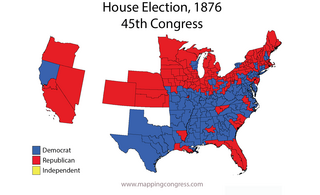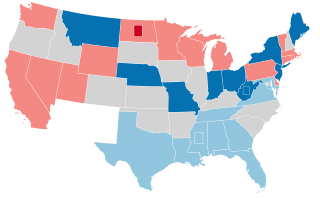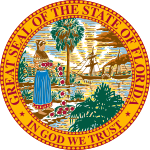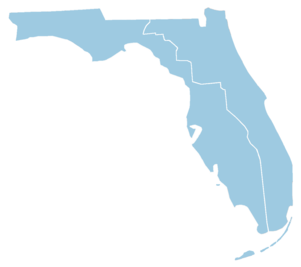
The 1876 United States presidential election was the 23rd quadrennial presidential election, held on Tuesday, November 7, 1876. Incumbent Republican president Ulysses S. Grant declined to run for a third term, so the party chose Rutherford B. Hayes, the governor of Ohio, as its nominee. The Democratic Party nominated New York governor Samuel J. Tilden as their nominee. It was one of the most contentious presidential elections in American history. Its resolution involved negotiations between the Republicans and Democrats, resulting in the Compromise of 1877, and on March 2, 1877, the counting of electoral votes by the House and Senate occurred, confirming Hayes as president. It was the second of five U.S. presidential elections in which the winner did not win a plurality of the national popular vote. This is the first time it happened since 1824. Following President Grant's decision to retire after his second term, U.S. Representative James G. Blaine emerged as the frontrunner for the Republican nomination. However, Blaine was unable to win a majority at the 1876 Republican National Convention, which settled on Governor Hayes of Ohio as a compromise candidate. The 1876 Democratic National Convention nominated Governor Tilden of New York on the second ballot.

Ossian Bingley Hart was the 10th Governor of Florida from 1872 to 1874, and the first governor of Florida who was born in the state.

The 1962 United States Senate elections was an election for the United States Senate. Held on November 6, the 34 seats of Class 3 were contested in regular elections. Special elections were also held to fill vacancies. They occurred in the middle of President John F. Kennedy's term. His Democratic Party made a net gain of four seats from the Republicans, increasing their control of the Senate to 68–32. However, this was reduced to 67–33 between the election and the next Congress, as on November 18, 1962, Democrat Dennis Chávez, who was not up for election that year, died. He was replaced on November 30, 1962, by Republican appointee Edwin L. Mechem. Additionally, Democrat Strom Thurmond became a Republican in 1964, further reducing Democrats to 66–34. This was the first time since 1932 that Democrats gained seats in this class of Senators.

The 1966 United States House of Representatives elections was an election for the United States House of Representatives on November 8, 1966, to elect members to serve in the 90th United States Congress. They occurred in the middle of President Lyndon B. Johnson's second term. As the Vietnam War continued to escalate and race riots exploded in cities across the country, Johnson's popularity had fallen, and the opposition Republican Party was able to gain a net of 47 seats from Johnson's Democratic Party, which nonetheless maintained a clear majority in the House. This was also the first election that occurred after the Voting Rights Act of 1965 became law, the first time since 1870 that a Republican won a House seat in Arkansas, and the first since 1876 that the party did so in South Carolina.

The 1876–77 United States House of Representatives elections were held on various dates in various states between June 5, 1876, and March 13, 1877. Each state set its own date for its elections to the House of Representatives before the first session of the 45th United States Congress convened on October 15, 1877. The size of the House increased to 293 seats with the addition of the new state of Colorado.

The Electoral Commission, sometimes referred to as the Hayes-Tilden or Tilden-Hayes Electoral Commission, was a temporary body created by the United States Congress on January 29, 1877, to resolve the disputed United States presidential election of 1876. Democrat Samuel J. Tilden and Republican Rutherford B. Hayes were the main contenders in the election. Tilden won 184 undisputed electoral votes, one vote shy of the 185 needed to win, to Hayes' 165, with 20 electoral votes from four states unresolved. Both Tilden and Hayes electors submitted votes from these states, and each claimed victory.

The 44th United States Congress was a meeting of the legislative branch of the United States federal government, consisting of the United States Senate and the United States House of Representatives. It met in Washington, D.C. from March 4, 1875, to March 4, 1877, during the seventh and eighth years of Ulysses S. Grant's presidency. The apportionment of seats in the House of Representatives was based on the 1870 United States census. For the first time since the American Civil War, the House had a Democratic majority. The Senate maintained a Republican majority.

The 1910–11 United States Senate election were held on various dates in various states. As these U.S. Senate elections were prior to the ratification of the Seventeenth Amendment in 1913, senators were primarily chosen by state legislatures. Senators were elected over a wide range of time throughout 1910 and 1911, and a seat may have been filled months late or remained vacant due to legislative deadlock. However, some states had already begun direct elections during this time. Oregon pioneered direct election and experimented with different measures over several years until it succeeded in 1907. Soon after, Nebraska followed suit and laid the foundation for other states to adopt measures reflecting the people's will. By 1912, as many as 29 states elected senators either as nominees of their party's primary or in conjunction with a general election.

The 2006 United States House of Representatives Elections in Florida took place on November 7, 2006. Elections were held in Florida's 1st through 25th congressional districts.

Elections in Florida are held on the first Tuesday after the first Monday of November in even-numbered years, as provided for in Article 6 of the Florida Constitution. For state elections, the Governor of Florida, Lieutenant Governor, and the members of the Florida Cabinet, and members of the Florida Senate are elected every four years; members of the Florida House of Representatives are elected every two years. In national elections, Florida plays an important role as the largest bellwether state, occasionally determining the outcome of elections for U.S. President — as it did in 1876 and in 2000.

George Pettus Raney was an American attorney and politician who served as the 9th Chief Justice of the Florida Supreme Court.
The 1880 United States House of Representatives elections in Florida were held November 2 for the 47th Congress. These elections were held at the same time as the presidential election and the election for governor.

The 1875 Pennsylvania gubernatorial election occurred on November 2, 1875. Incumbent governor John F. Hartranft, a Republican, was a candidate for re-election. Hartranft defeated Democratic candidate Cyrus L. Pershing to win another term.

The 1956 United States Senate election in Florida was held on November 6, 1956. Incumbent Democratic U.S. Senator George Smathers won re-election to a second term.

The 1962 United States Senate election in Florida took place on November 6, 1962. Incumbent Democratic Senator George Smathers won re-election to a third term. As of 2023, this is the last time that a winning United States Senate candidate carried all counties in Florida for the Class 3 Senate seat from Florida and the last time that a winning United States Senate candidate carried all counties in Florida for a Senate seat from Florida until 1994.

William Archer Cocke was an American attorney and politician who served as the 13th Florida Attorney General. Cocke was placed into the national spotlight due to his role in the controversy following the 1876 presidential election.

The 2022 Florida gubernatorial election was held on November 8, 2022, to elect the governor of Florida, alongside other state and local elections. Incumbent Republican Party governor Ron DeSantis won re-election in a landslide and defeated the Democratic Party nominee, former U.S. representative Charlie Crist, who previously served as governor of Florida from 2007 to 2011 as a Republican and later as an Independent. No Democrat has been elected governor of Florida since 1994.
Samuel B. McLin served as Florida Secretary of State from 1873 until 1877, and as a justice of the New Mexico Territorial Supreme Court from 1877 to 1878. He was involved in Florida's delegate counting feud during the disputed 1876 United States presidential election between Republican Rutherford B. Hayes and Democrat Samuel Tilden.
Clayton Augustus Cowgill was an American surgeon who served as Florida Comptroller from January 15, 1873 to January 12, 1877. Florida's governor appointed him to the Board of Canvassers to resolve the disputed November 1876 election. He was a Republican who served in Republican governor Ossian B. Hart's cabinet.




















